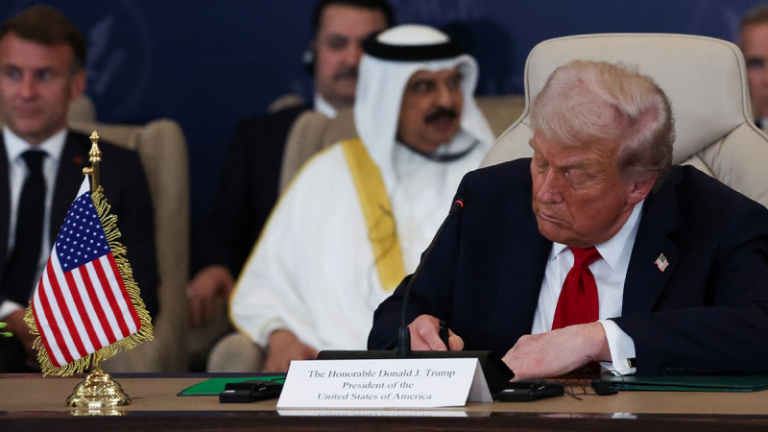The guns have gone quiet over Gaza — for now. After years of darkness, the region has entered a new phase shaped by President Donald Trump’s decisive leadership and the landmark 20‑point Gaza peace deal. Hostages have come home, Hamas has been driven underground, and an American‑backed peace architecture has emerged where fire once raged.
For the first time in decades, Israelis and Arabs alike can glimpse something extraordinary: a path forward. Yet history reminds us that in the Middle East, every dawn carries both promise and peril. Which road will this new dawn take?
1. The golden horizon — prosperity through peace
In the most hopeful scenario, Trump’s peace‑through‑strength doctrine takes root across the region. Arab nations once divided by ideology are now united by opportunity. Saudi Arabia and the Emirates invest in Gaza’s reconstruction. Egypt and Jordan join a multinational stabilization force. Israeli innovation fuses with Gulf capital to create a ‘New Abraham Corridor’ stretching from Haifa to Mumbai — a network of trade, fiber and trust.
If momentum continues, the Middle East could experience its most dynamic decade of growth in modern history, a true dividend of deterrence where strength sustains peace. This is the world imagined in Trump’s vision: when America leads with conviction, peace and prosperity follow.
2. The Phoenix of Persia — Iran rises again
Iran today lies bruised after its 12‑day war with Israel — its nuclear facilities shattered and its clerical regime faltering under global sanctions and internal dissent. But as history proves, Tehran’s rulers are nothing if not resilient. Should the Revolutionary Guard tighten its grip after Ayatollah Khamenei’s death (He’s 86 now and in fragile health.), the Islamic Republic could re‑ignite its ‘Axis of Resistance,’ funneling arms to Gaza, Lebanon and Yemen.
A revived Iran — driven less by theology than by vengeance — could again bankroll Hamas, Hezbollah and the Houthis, destabilizing every border from the Golan to the Gulf. That path leads not to peace but to another round of rockets.
3. The mirage of coexistence — Hamas rebrands and regroups
Even as the ink dries on the ceasefire, Hamas cadres are reportedly resurfacing under new guises — embedding themselves in Gaza’s police, charities and reconstruction committees. As analyst Matthew Levitt warned in Foreign Affairs, Hamas is ‘not done fighting.’ It has survived isolation before — after Oslo, after 2014, after the October 2023 massacre. If it is allowed to mutate rather than disarm, today’s peace will become tomorrow’s deception.
4. The fragmented peace — a cold stability
A more modest outcome is a Middle East trapped in uneasy calm. Israel remains wary, Arab states distracted and Gaza suspended between aid and anarchy. The Palestinian Authority governs half‑heartedly — half technocrats, half radicals. Donors rebuild while militants lurk in the shadows. This scenario mirrors Lebanon’s long stagnation: peace without progress, stability without spirit. Better than war — but a waste of the rarest currency in the Middle East: hope.
5. The renaissance scenario — a new Arab‑Israeli compact
History proves that courage can rewrite destiny. When Egyptian President Anwar Sadat made peace with Israel in 1979, he was condemned across the Arab world — yet his boldness built the foundation of modern regional stability.
Today’s leaders face a similar choice. If Arab reformers and Israeli visionaries link economic corridors, energy grids and AI‑driven infrastructure, they could transform the ‘war economy’ into a peace economy — creating jobs, dignity and shared destiny for millions of young Arabs.
A strategy to lock in the light
Peace must be protected with the same vigilance once used for war. To preserve this dawn:
Enforce the disarmament clauses of the Gaza accord through a multinational stabilization mission with real teeth, funded by the U.S., Gulf states and the EU.
Starve Iran’s proxies of cash and narrative — every diverted aid dollar or false grievance must meet swift exposure and penalty.
Reward reformers, isolate spoilers. States that promote coexistence should earn trade incentives and security partnerships; those that relapse into terror should face diplomatic quarantine.
This is not nation‑building — it is peace‑proofing: the disciplined engineering of stability.
Choosing the future
The Middle East now stands at a crossroads of consequence. Down one path lies renewal — an alliance of nations liberated from fear. Down another lies relapse into the inferno that has burned for generations. The difference will be leadership.
If Arab reformers and Israeli visionaries link economic corridors, energy grids and AI‑driven infrastructure, they could transform the ‘war economy’ into a peace economy — creating jobs, dignity and shared destiny for millions of young Arabs.
If America remains engaged — clear‑eyed, strong‑handed and morally grounded — the ‘New Dawn’ President Trump proclaimed before the Knesset could become the defining achievement of our era. But if Washington drifts or the world looks away, Gaza’s fragile peace will fade into memory, and the old fires will reignite.
A bright horizon
Yet hope endures. Across the Middle East, from Jerusalem to Riyadh, young men and women are daring to imagine a future not ruled by grievance but by greatness. Trade routes reopen. Technology hubs rise. Faith and freedom, long estranged, begin to walk together.
The Middle East has lived too long in the valley of shadows. Now it stands on the ridge of renewal — and if America continues to lead with faith and firmness, the dawn that rose over Gaza could light the world.

